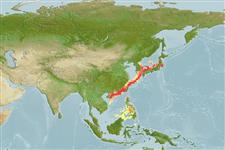Classification / Names
Common names from other countries
Main reference
Size / Weight / Age
Max length : 18.0 cm TL male/unsexed; (Ref. 56527); common length : 14.0 cm TL male/unsexed; (Ref. 56527); max. published weight: 45.00 g (Ref. 56527); max. reported age: 4 years (Ref. 56527)
Length at first maturity
Lm ?, range 10 - 11 cm
Environment
Marine; pelagic-neritic; oceanodromous (Ref. 51243); depth range 0 - 400 m (Ref. 50550)
Climate / Range
Temperate; 8°C - 30°C (Ref. 56557), preferred 25°C (Ref. 107945); 49°N - 2°N, 105°E - 160°E (Ref. 54432)
Distribution
Western Pacific: southern Sakhalin Islands, Sea of Japan and Pacific coasts of Japan, and south to almost Canton/Taiwan; rare records (seems to represent stray fishes) off the coasts of Luzon and Western Mindanao, Philippines and from Manado and Ujung Pandang, Sulawesi, Indonesia (Ref. 189).
Countries | FAO areas | Ecosystems | Occurrences | Introductions
Short description
Dorsal
spines
(total): 0;
Dorsal
soft rays
(total): 12-14;
Anal
spines: 0;
Anal
soft rays: 13 - 18. Differs very little from the European anchovy (see E. encrasicolus) and can be identified from that description. Of other anchovies found in the southern part of its distribution, only species of Encrasicholina and Stolephorus are of similar appearance, but all have small spine-like pre-pelvic scutes (usually 2 to 7 scutes). Thryssa have compressed bodies and a keel of scutes along belly.
IUCN Red List Status (Ref. 115185)
Threat to humans
Reports of ciguatera poisoning (Ref. 4690)
Human uses
Fisheries: highly commercial; aquaculture: commercial; bait: usually
Tools
Special reports
Download XML
Internet sources
Estimates of some properties based on models
Phylogenetic diversity index
PD50 = 0.5020 many relatives (e.g. carps) 0.5 - 2.0 few relatives (e.g. lungfishes)
Trophic Level
3.1 ±0.1 se; Based on diet studies.
Resilience
High, minimum population doubling time less than 15 months (K=1.05; tm=1-2; tmax=3)
Vulnerability
Low vulnerability (10 of 100)
Price category
